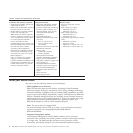threshold or if a system component fails, the IMM lights LEDs to help you
diagnose the problem, records the error in the IMM event log, and alerts you to
the problem. Optionally, the IMM also provides a virtual presence capability for
remote server management capabilities. The IMM provides remote server
management through industry-standard interfaces:
– Intelligent Platform Management Interface (IPMI) version 2.0
– Simple Network Management Protocol (SNMP) version 3
– Common Information Model (CIM)
– Web browser (For more information, see “Using the integrated management
module” on page 104.)
v IBM Systems Director
IBM Systems Director is a platform-management foundation that streamlines the
way you manage physical and virtual systems in a heterogeneous environment.
By using industry standards, IBM Systems Director supports multiple operating
systems and virtualization technologies for IBM and non-IBM x86 platforms. For
more information, see the documentation on the IBM Systems Director DVD and
“IBM Systems Director” on page 12.
v IBM Electronic Service Agent
IBM Electronic Service Agent is a software tool that monitors the server for
hardware error events and automatically submits electronic service requests to
IBM service and support. Also, it can collect and transmit system configuration
information on a scheduled basis so that the information is available to you and
your support representative. It uses minimal system resources, is available free
of charge, and can be downloaded from the web. For more information and to
download Electronic Service Agent, go to http://www.ibm.com/support/
electronic/.
v IBM X-Architecture
®
technology
IBM X-Architecture technology combines proven, innovative IBM designs to
make your x86-processor-based server powerful, scalable, and reliable. For more
information, see http://www.ibm.com/servers/eserver/xseries/xarchitecture/
enterprise/index.html.
v Large system-memory capacity
The server supports up to 1 TB of system memory. The memory controller
supports error correcting code (ECC) for up to 64 industry-standard PC3-10600,
240-pin, registered, double-data-rate (DDR) III, synchronous dynamic random
access memory (SDRAM) dual inline memory modules (DIMMs). The optional
32-DIMM IBM MAX5 for System x memory expansion module is available for
purchase and provides up to 512 GB of additional memory. For more
information about the memory expansion module, see “IBM MAX5 for System x
memory expansion module” on page 21.
v Memory ProteXion
The Memory ProteXion feature provides the equivalent of a hot-spare drive in a
RAID array. It is based in the memory controller, and it enables the server to
sense when a chip on a DIMM has failed and to route the data around the failed
chip.
v Memory Sparing
The server supports memory sparing. Memory sparing reserves memory
capacity for failover in the event of a DIMM failure, and the reserved capacity is
subtracted from the total available memory. Memory sparing provides less
redundancy than memory mirroring does. If a predetermined threshold of
correctable errors is reached, the contents of the failing DIMM are copied to the
spare memory, and the failing DIMM or rank is disabled. To enable memory
Chapter 1. The System x3850 X5 and x3950 X5 server 9


















